诸神缄默不语-个人CSDN博文目录
huggingface transformers包 文档学习笔记(持续更新ing…)
本文主要介绍使用AutoModelForTokenClassification在典型序列识别任务,即命名实体识别任务 (NER) 上,微调Bert模型。
主要参考huggingface官方教程:Token classification
本文中给出的例子是英文数据集,且使用transformers.Trainer来训练,以后可能会补充使用中文数据、使用原生PyTorch框架的训练代码。
使用原生PyTorch框架反正不难,可以参考文本分类那边的改法:用huggingface.transformers.AutoModelForSequenceClassification在文本分类任务上微调预训练模型
整个代码是用VSCode内置对Jupyter Notebook支持的编辑器来写的,所以是分cell的。
序列标注和NER都是啥我就不写了,之前笔记写过的我也尽量都不写了。
本文直接使用本地已下载好的checkpoint文件夹路径来调取预训练模型。checkpoint下载自:https://huggingface.co/distilbert-base-uncased
需要预先安装包:pip install datasets evaluate seqeval
文章目录
1. 登录huggingface
虽然不用,但是登录一下(如果在后面训练部分,将push_to_hub入参置为True的话,可以直接将模型上传到Hub)
from huggingface_hub import notebook_login
notebook_login()
输出:
Login successful
Your token has been saved to my_path/.huggingface/token
Authenticated through git-credential store but this isn't the helper defined on your machine.
You might have to re-authenticate when pushing to the Hugging Face Hub. Run the following command in your terminal in case you want to set this credential helper as the default
git config --global credential.helper store
2. 数据集:WNUT 17
直接运行load_dataset()会报ConnectionError,所以可参考之前我写过的huggingface.datasets无法加载数据集和指标的解决方案先下载到本地,然后加载:
import datasets
wnut=datasets.load_from_disk('/data/datasets_file/wnut17')
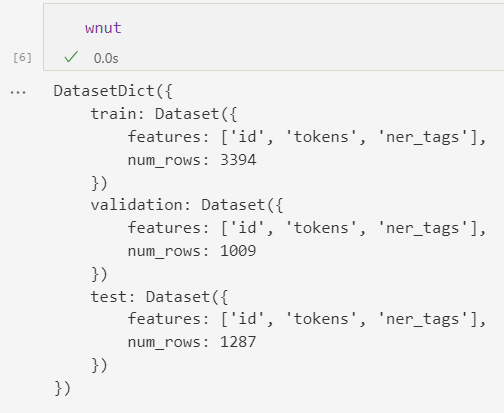
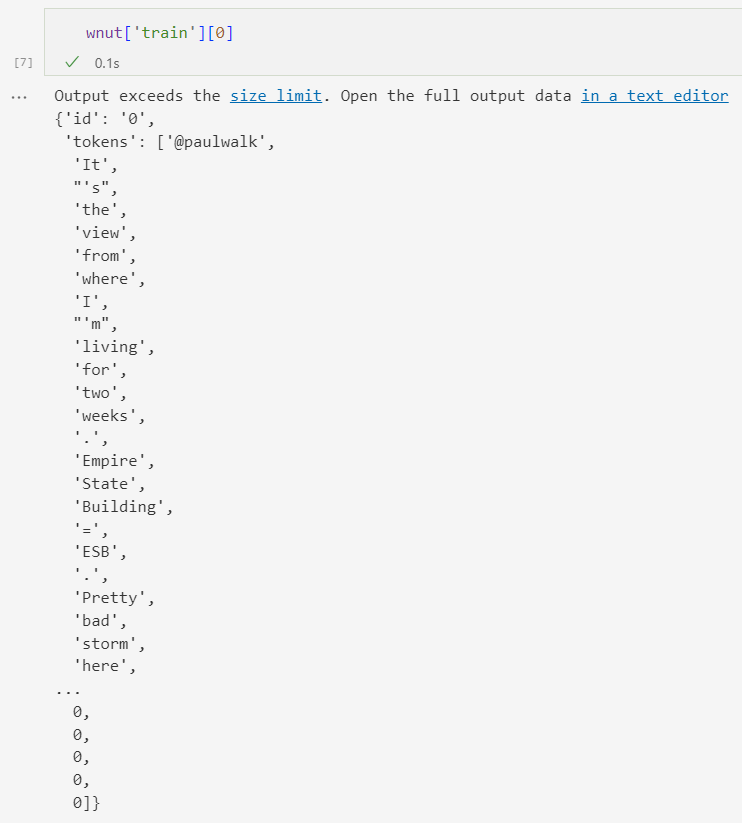
ner_tags数字对应的标签:
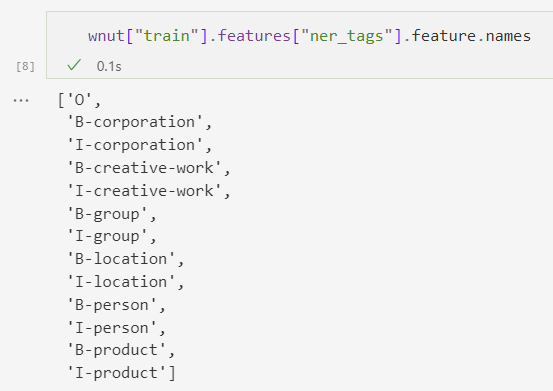
3. 数据预处理
from transformers import AutoTokenizer
tokenizer = AutoTokenizer.from_pretrained("/data/pretrained_model/distilbert-base-uncased")
在上面可以看到,文本已经以词为单位进行了分割。对这种文本用DisdilBert进行tokenize的示例:
example = wnut["train"][0]
tokenized_input = tokenizer(example["tokens"], is_split_into_words=True)
tokens = tokenizer.convert_ids_to_tokens(tokenized_input["input_ids"])
tokens
输出:

可以看出,有增加special tokens、还有把word变成subword,这都使原标签序列与现在的token序列不再对应,因此现在需要重新匹配与token序列对应的标签序列:
3. 用token对应的word_ids1匹配原属的word,也就匹配到了原属的标签。只标注第一个subword的标签
4. 第二个及以后subword,和special tokens的标签标注为-100。这样会自动使PyTorch计算交叉熵损失函数时忽略这些token。在后续计算指标时需要另行考虑对这些token进行处理
(注意这里的-100,在教程中说这样会被PyTorch损失函数忽略,我一开始很震惊,因为在教程中没有在损失函数处考虑-100,而且DistilBertForTokenClassifcation源码2里面算loss时显然也没有考虑这回事,
然后我去百度了一下,发现……
是PyTorch的CrossEntropyLoss默认忽略-100值(捂脸):

(图片截自PyTorch官方文档3)
我之前还在huggingface论坛里提问了,我还猜想是别的原因,跑去提问,果然没人回4,最后还得靠我自己查
2023.7.11补充:好家伙,有人回复了,笑死)
5. truncation=True:将文本truncate到模型的最大长度
这是一个批量处理代码:
def tokenize_and_align_labels(examples):
tokenized_inputs = tokenizer(examples["tokens"], truncation=True, is_split_into_words=True)
labels = []
for i, label in enumerate(examples[f"ner_tags"]):
word_ids = tokenized_inputs.word_ids(batch_index=i) #返回batch_index对应的batch中的序列索引的token对应的word id列表(special tokens是None)
previous_word_idx = None
label_ids = []
for word_idx in word_ids: # Set the special tokens to -100.
if word_idx is None:
label_ids.append(-100)
elif word_idx != previous_word_idx: # Only label the first token of a given word.
label_ids.append(label[word_idx])
else:
label_ids.append(-100)
previous_word_idx = word_idx
labels.append(label_ids)
tokenized_inputs["labels"] = labels
return tokenized_inputs
- is_split_into_words:以词为列表元素输入文本
- return_offsets_mapping:返回每个token的
(char_start, char_end) - truncation / padding(这里没有直接应用padding,应该是因为后面直接使用DataCollatorWithPadding来实现padding了)
将批量预处理的代码应用在数据集上(batched=True入参使一次可处理多个元素):
tokenized_wnut = wnut.map(tokenize_and_align_labels, batched=True)

为了实现mini-batch,直接用原生PyTorch框架的话就是建立DataSet和DataLoader对象之类的,也可以直接用DataCollatorWithPadding:动态将每一batch padding到最长长度,而不用直接对整个数据集进行padding;能够同时padding label:
from transformers import DataCollatorForTokenClassification
data_collator = DataCollatorForTokenClassification(tokenizer=tokenizer)
(没查具体pad label的方式。总之如果想手动预处理数据的话,可以先定义一个所有值都是-100的列表)
4. 建立评估指标
evaluate库:🤗 Evaluate
import evaluate
seqeval = evaluate.load("seqeval")
建立计算指标的函数:将logits转换为预测标签(过argmax),删除-100标签的token
label_list = wnut["train"].features[f"ner_tags"].feature.names #BIO
import numpy as np
def compute_metrics(p):
predictions, labels = p
predictions = np.argmax(predictions, axis=2)
true_predictions = [
[label_list[p] for (p, l) in zip(prediction, label) if l != -100]
for prediction, label in zip(predictions, labels)
]
true_labels = [
[label_list[l] for (p, l) in zip(prediction, label) if l != -100]
for prediction, label in zip(predictions, labels)
]
results = seqeval.compute(predictions=true_predictions, references=true_labels)
return {
"precision": results["overall_precision"],
"recall": results["overall_recall"],
"f1": results["overall_f1"],
"accuracy": results["overall_accuracy"],
}
compute()的文档:https://huggingface.co/docs/evaluate/v0.4.0/en/package_reference/main_classes#evaluate.EvaluationModule.compute
5. 训练
id2label = {
0: "O",
1: "B-corporation",
2: "I-corporation",
3: "B-creative-work",
4: "I-creative-work",
5: "B-group",
6: "I-group",
7: "B-location",
8: "I-location",
9: "B-person",
10: "I-person",
11: "B-product",
12: "I-product",
}
label2id = {
"O": 0,
"B-corporation": 1,
"I-corporation": 2,
"B-creative-work": 3,
"I-creative-work": 4,
"B-group": 5,
"I-group": 6,
"B-location": 7,
"I-location": 8,
"B-person": 9,
"I-person": 10,
"B-product": 11,
"I-product": 12,
}
from transformers import AutoModelForTokenClassification, TrainingArguments, Trainer
model = AutoModelForTokenClassification.from_pretrained(
"/data/pretrained_model/distilbert-base-uncased/", num_labels=13, id2label=id2label, label2id=label2id
)
- 定义训练超参(需要指定保存模型的文件夹路径)
如果将push_to_hub置True,将使训练好的模型自动上传到Hub,这需要登录huggingface账号(可以用hub_model_id入参设置完整的repo名,需要包括namespace,如sgugger/bert-finetuned-ner)
每个epoch最后会评估seqeval指标
https://huggingface.co/docs/transformers/v4.27.2/en/main_classes/trainer#transformers.TrainingArguments
(本项目中没有传入,默认的第一个入参是model_name) - 将超参、模型、数据集、指标计算函数传入Trainer
https://huggingface.co/docs/transformers/v4.27.2/en/main_classes/trainer#transformers.Trainer - 微调模型
https://huggingface.co/docs/transformers/v4.27.2/en/main_classes/trainer#transformers.Trainer.train
(注意这个代码会自动调用wandb包……我是没想到的,港真。项目是huggingface,run的名称就是output_dir的值)
training_args = TrainingArguments(
output_dir="/data/wanghuijuan/pretrained_model/my_awesome_wnut_model",
learning_rate=2e-5,
per_device_train_batch_size=16,
per_device_eval_batch_size=16,
num_train_epochs=2,
weight_decay=0.01,
evaluation_strategy="epoch",
save_strategy="epoch",
load_best_model_at_end=True,
push_to_hub=False,
)
trainer = Trainer(
model=model,
args=training_args,
train_dataset=tokenized_wnut["train"],
eval_dataset=tokenized_wnut["test"],
tokenizer=tokenizer,
data_collator=data_collator,
compute_metrics=compute_metrics,
)
trainer.train()
模型会自动上多卡进行训练。我服务器上4张卡都能用,所以1个batch可以跑64个样本
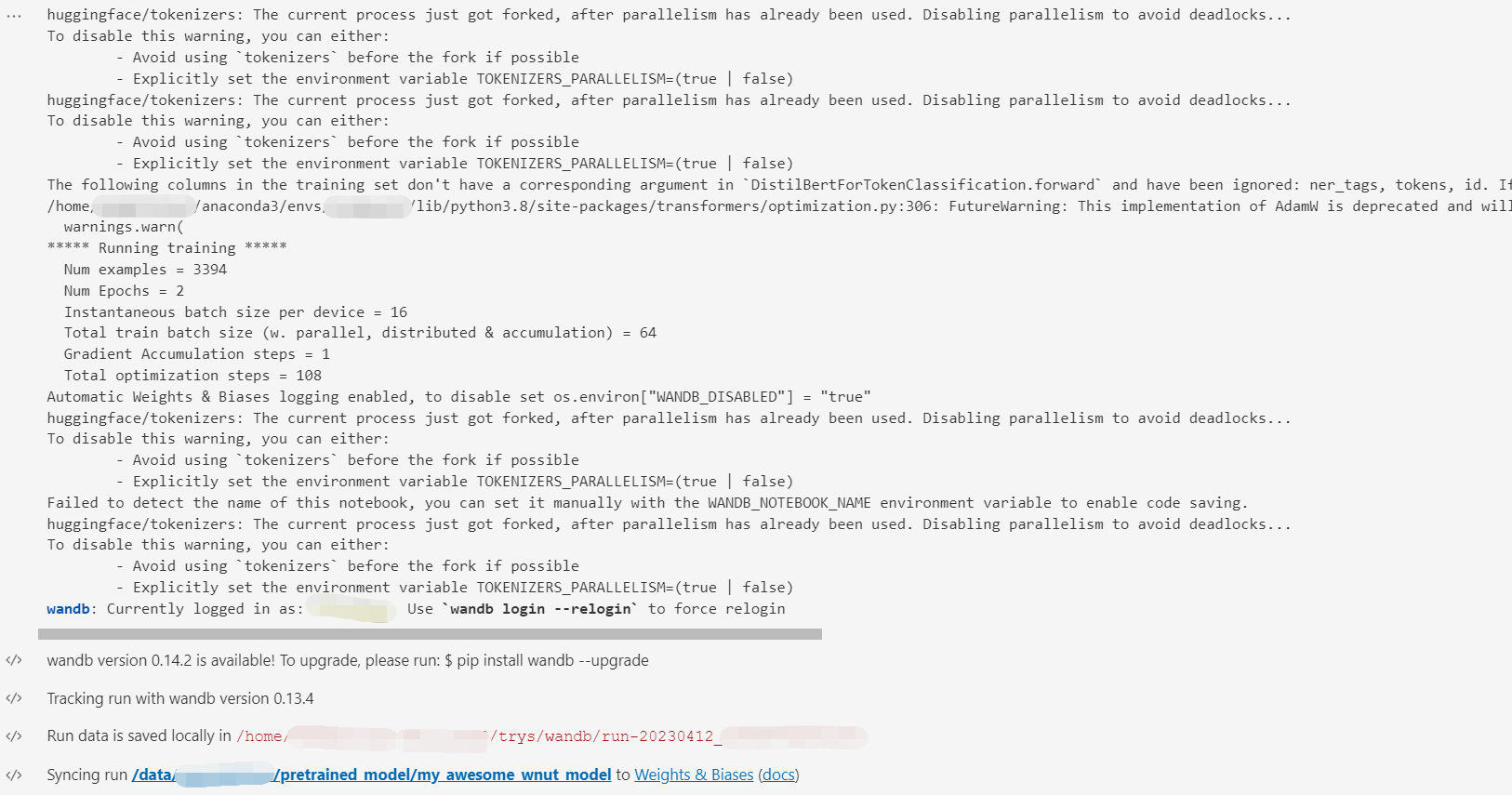
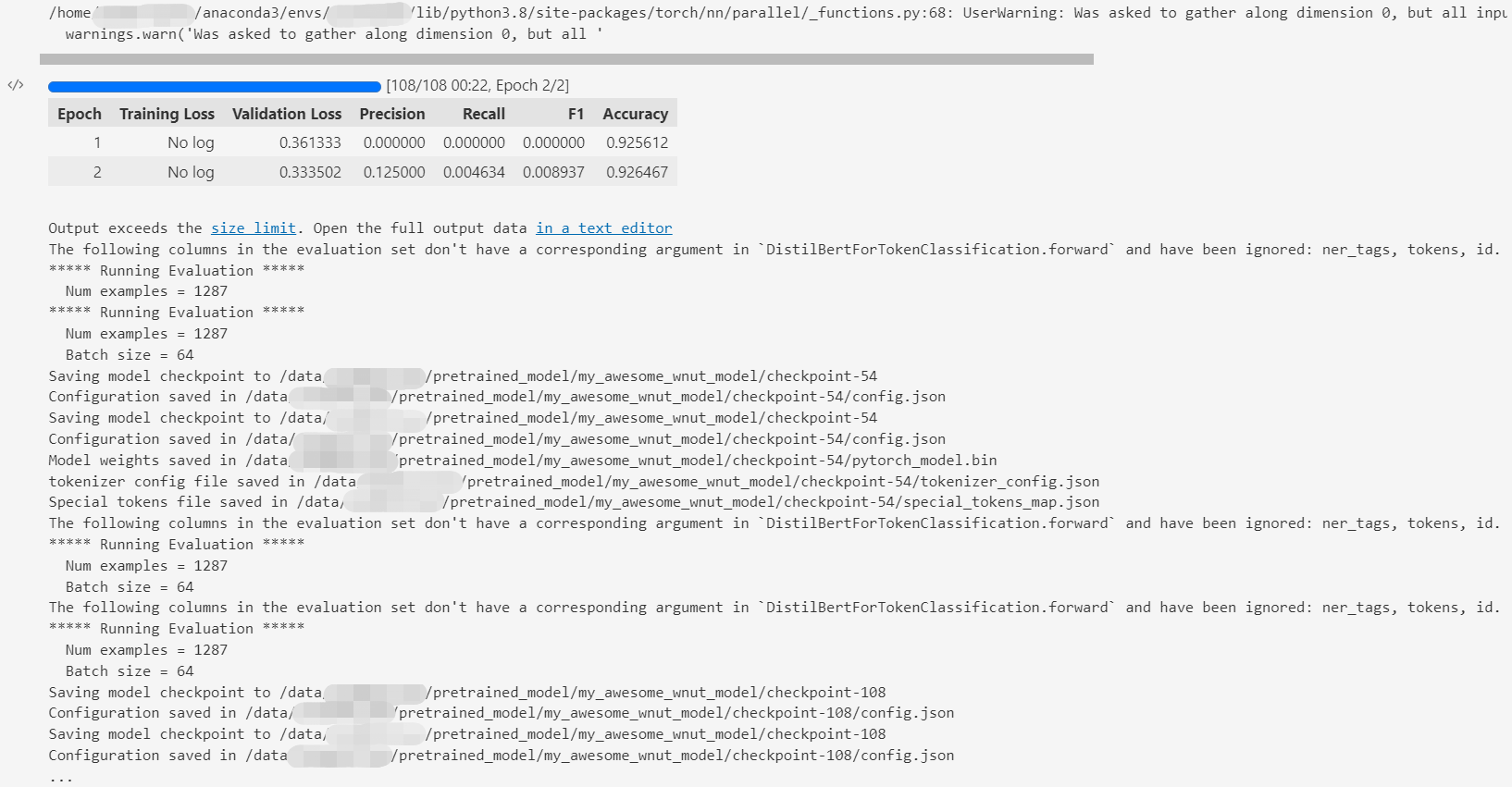
Training completed. Do not forget to share your model on huggingface.co/models =)
Loading best model from /data/pretrained_model/my_awesome_wnut_model/checkpoint-108 (score: 0.3335016071796417).
TrainOutput(global_step=108, training_loss=0.42667872817428026, metrics={'train_runtime': 38.1861, 'train_samples_per_second': 177.761, 'train_steps_per_second': 2.828, 'total_flos': 103933773439080.0, 'train_loss': 0.42667872817428026, 'epoch': 2.0})
wandb的图懒得截了
如果想把模型上传到Hub:trainer.push_to_hub()(https://huggingface.co/docs/transformers/v4.27.2/en/main_classes/trainer#transformers.Trainer.push_to_hub)
另外一种写法:https://colab.research.google.com/github/huggingface/notebooks/blob/main/examples/token_classification.ipynb#scrollTo=7sZOdRlRIrJd(别的都差不多,比较明显的区别就是:计算指标是用datasets库,数据集是按照比较标准的训练集-验证集-测试集模式来实现的)
6. 推理
text = "The Golden State Warriors are an American professional basketball team based in San Francisco."
(我第一次跑出来的结果有问题,完全不能正确预测结果,所以我重跑了一次,就不改上面一节的截图了)
6.1 直接使用pipeline
from transformers import pipeline
classifier=pipeline("ner",model="/data/pretrained_model/my_awesome_wnut_model/checkpoint-108")
classifier(text)
输出的警告内容:
loading configuration file /data/pretrained_model/my_awesome_wnut_model/checkpoint-108/config.json
Model config DistilBertConfig {
"_name_or_path": "/data/pretrained_model/my_awesome_wnut_model/checkpoint-108",
"activation": "gelu",
"architectures": [
"DistilBertForTokenClassification"
],
"attention_dropout": 0.1,
"dim": 768,
"dropout": 0.1,
"hidden_dim": 3072,
"id2label": {
"0": "O",
"1": "B-corporation",
"2": "I-corporation",
"3": "B-creative-work",
"4": "I-creative-work",
"5": "B-group",
"6": "I-group",
"7": "B-location",
"8": "I-location",
"9": "B-person",
"10": "I-person",
"11": "B-product",
"12": "I-product"
},
"initializer_range": 0.02,
"label2id": {
"B-corporation": 1,
"B-creative-work": 3,
"B-group": 5,
"B-location": 7,
"B-person": 9,
"B-product": 11,
"I-corporation": 2,
"I-creative-work": 4,
"I-group": 6,
"I-location": 8,
"I-person": 10,
"I-product": 12,
"O": 0
},
"max_position_embeddings": 512,
"model_type": "distilbert",
"n_heads": 12,
"n_layers": 6,
"pad_token_id": 0,
"qa_dropout": 0.1,
"seq_classif_dropout": 0.2,
"sinusoidal_pos_embds": false,
"tie_weights_": true,
"torch_dtype": "float32",
"transformers_version": "4.21.1",
"vocab_size": 30522
}
loading configuration file /data/pretrained_model/my_awesome_wnut_model/checkpoint-108/config.json
Model config DistilBertConfig {
"_name_or_path": "/data/pretrained_model/my_awesome_wnut_model/checkpoint-108",
"activation": "gelu",
"architectures": [
"DistilBertForTokenClassification"
],
"attention_dropout": 0.1,
"dim": 768,
"dropout": 0.1,
"hidden_dim": 3072,
"id2label": {
"0": "O",
"1": "B-corporation",
"2": "I-corporation",
"3": "B-creative-work",
"4": "I-creative-work",
"5": "B-group",
"6": "I-group",
"7": "B-location",
"8": "I-location",
"9": "B-person",
"10": "I-person",
"11": "B-product",
"12": "I-product"
},
"initializer_range": 0.02,
"label2id": {
"B-corporation": 1,
"B-creative-work": 3,
"B-group": 5,
"B-location": 7,
"B-person": 9,
"B-product": 11,
"I-corporation": 2,
"I-creative-work": 4,
"I-group": 6,
"I-location": 8,
"I-person": 10,
"I-product": 12,
"O": 0
},
"max_position_embeddings": 512,
"model_type": "distilbert",
"n_heads": 12,
"n_layers": 6,
"pad_token_id": 0,
"qa_dropout": 0.1,
"seq_classif_dropout": 0.2,
"sinusoidal_pos_embds": false,
"tie_weights_": true,
"torch_dtype": "float32",
"transformers_version": "4.21.1",
"vocab_size": 30522
}
loading weights file /data/pretrained_model/my_awesome_wnut_model/checkpoint-108/pytorch_model.bin
All model checkpoint weights were used when initializing DistilBertForTokenClassification.
All the weights of DistilBertForTokenClassification were initialized from the model checkpoint at /data/pretrained_model/my_awesome_wnut_model/checkpoint-108.
If your task is similar to the task the model of the checkpoint was trained on, you can already use DistilBertForTokenClassification for predictions without further training.
Didn't find file /data/pretrained_model/my_awesome_wnut_model/checkpoint-108/added_tokens.json. We won't load it.
loading file /data/pretrained_model/my_awesome_wnut_model/checkpoint-108/vocab.txt
loading file /data/pretrained_model/my_awesome_wnut_model/checkpoint-108/tokenizer.json
loading file None
loading file /data/pretrained_model/my_awesome_wnut_model/checkpoint-108/special_tokens_map.json
loading file /data/pretrained_model/my_awesome_wnut_model/checkpoint-108/tokenizer_config.json
Asking to truncate to max_length but no maximum length is provided and the model has no predefined maximum length. Default to no truncation.
输出:
[{'entity': 'B-group',
'score': 0.28309435,
'index': 1,
'word': 'the',
'start': 0,
'end': 3},
{'entity': 'B-location',
'score': 0.41352233,
'index': 2,
'word': 'golden',
'start': 4,
'end': 10},
{'entity': 'I-location',
'score': 0.44743603,
'index': 3,
'word': 'state',
'start': 11,
'end': 16},
{'entity': 'B-group',
'score': 0.2455212,
'index': 4,
'word': 'warriors',
'start': 17,
'end': 25},
{'entity': 'B-location',
'score': 0.2583066,
'index': 7,
'word': 'american',
'start': 33,
'end': 41},
{'entity': 'B-location',
'score': 0.54653203,
'index': 13,
'word': 'san',
'start': 80,
'end': 83},
{'entity': 'B-location',
'score': 0.43548092,
'index': 14,
'word': 'francisco',
'start': 84,
'end': 93},
{'entity': 'I-location',
'score': 0.16240601,
'index': 15,
'word': '.',
'start': 93,
'end': 94}]
6.2 使用模型实现推理
import torch
model.to('cpu')
inputs = tokenizer(text, return_tensors="pt")
with torch.no_grad():
logits = model(**inputs).logits
predictions = torch.argmax(logits, dim=2)
predicted_token_class = [model.config.id2label[t.item()] for t in predictions[0]]
predicted_token_class
['O',
'B-group',
'B-location',
'I-location',
'I-group',
'O',
'O',
'O',
'O',
'O',
'O',
'O',
'O',
'B-location',
'B-location',
'I-location',
'I-location']
理论上这里还应该有一步把原始token和预测值对应起来,但是教程里没写,我也懒得写了。
7. 其他本文撰写过程中使用的参考资料
- 利用huggingface的transformers库在自己的数据集上实现中文NER(命名实体识别) - 知乎
- HuggingFace Datasets来写一个数据加载脚本_名字填充中的博客-CSDN博客:这个是讲如何将自己的数据集构建为datasets格式的数据集的
- huggingface使用BERT对自己的数据集进行命名实体识别方法_vanilla_hxy的博客-CSDN博客:这个是用transformers官方token classification示例代码来改的代码
- Huggingface-transformers项目源码剖析及Bert命名实体识别实战_野猪向前冲_真的博客-CSDN博客:这篇前半部分看起来还可以,看到第5节的时候发现图挂了……天涯何处无芳草,我不看了,润!
- PyTorch学习—12.损失函数_ignore_index is not supported for floating point t_哎呦-_-不错的博客-CSDN博客
https://huggingface.co/docs/transformers/v4.27.2/en/main_classes/tokenizer#transformers.BatchEncoding.word_ids
(顺带一提,原文档的超链接似乎给错了,我已经提issue了:Report a hyperlink mistake · Issue #739 · huggingface/hub-docs) ↩︎https://github.com/huggingface/transformers/blob/fe1f5a639d93c9272856c670cff3b0e1a10d5b2b/src/transformers/models/distilbert/modeling_distilbert.py#L939 ↩︎
https://pytorch.org/docs/stable/generated/torch.nn.CrossEntropyLoss.html#torch.nn.CrossEntropyLoss ↩︎
https://discuss.huggingface.co/t/will-trainer-loss-functions-automatically-ignore-100/36134 ↩︎






















 1140
1140











 被折叠的 条评论
为什么被折叠?
被折叠的 条评论
为什么被折叠?










